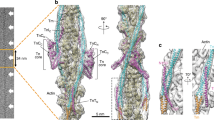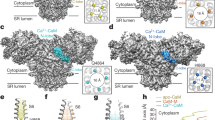Abstract
THE rapid removal of Ca2+ ions from the cytosol, necessary for the efficient relaxation of cardiac muscle cells, is performed by the Ca2+-pumping ATPase of the sarcoplasmic reticulum. The calcium pump is activated by cyclic AMP- and calmodulin-dependent phosphorylation of phospholamban, an integral membrane protein of the sarcoplasmic reticulum. Using a heterobifunctional crosslinking agent which can be cleaved and photoactivated, we provide evidence for a direct interaction between the two proteins. Only the non-phosphorylated form of phospholamban interacts with the ATPase, demonstrating that phospholamban is an endogenous inhibitor that is removed from the ATPase by phosphorylation. Non-phosphorylated phospholamban interacts only with the calcium-free conformation of the ATPase and is released when it is converted to the calcium-bound state. We localized the site of interaction to a single peptide isolated after cyanogen bromide cleavage of the ATPase. The peptide derives from a domain just C-terminal to the aspartyl phosphate of the active site. This domain is unique to ATPases of the sarcoplasmic reticulum in that it has no homology with any other phosphorylation-type ion pump. The domain occurs in both slow- and fast-twitch isoforms of the ATPase, even though phospholamban is not expressed in fast-twitch muscles.
This is a preview of subscription content, access via your institution
Access options
Subscribe to this journal
Receive 51 print issues and online access
$199.00 per year
only $3.90 per issue
Buy this article
- Purchase on Springer Link
- Instant access to full article PDF
Prices may be subject to local taxes which are calculated during checkout
Similar content being viewed by others
References
Fujii, J. et al. J. clin. Invest. 79, 301–304 (1987).
Wegener, A. D., Simmerman, H. K., Liepniesks, J. & Jones, L. R. J. biol. Chem. 261, 5154–5159 (1986).
Lindemann, J. P., Jones, L. R., Hathaway, D. R., Henry, B. G. & Watanabe, A. M. J. biol. Chem. 258, 464–471 (1983).
Garvey, J. L., Kranias, E. G. & Solaro, R. J. Biochem. J. 249, 709–714 (1988).
Inui, M., Kadoma, M. & Tada, M. J. biol. Chem. 260, 3706–3715 (1985).
Denny, J. B. & Blobel, G. Proc. natn. Acad Sci. U.S.A. 81, 5286–5290 (1984).
Inui, M., Chamberlain, B. K., Saito, A. & Fleischer, S. J. biol. Chem. 261, 1794–1800 (1986).
Suzuki, T. & Wang, J. H. J. biol. Chem. 261, 7018–7023 (1986).
Kirchberger, M. A., Borchman, D. & Kasinathan, C. Biochemistry 25, 5484–5492 (1986).
Dupont, Y. Biochim. biophys. Acta 688, 75–87 (1982).
Inesi, G. A. Rev. Physiol. 47, 573–601 (1985).
Tada, M. et al. J. biol. Chem. 255, 1985–1992 (1980).
Tada, M., Kirchberger, M. A. & Katz, A. M. J. biol. Chem. 250, 2640–2647 (1975).
Tada, M. & Katz, A. M. A. Rev. Physiol. 44, 401–423 (1982).
Chiesi, M. & Schwaller, R. FEBS Lett. 244, 241–244 (1989).
Tada, M., Ohmori, F., Yamada, M. & Abe, H. J. biol. Chem. 254, 319–326 (1979).
James, P. et al. J. biol. Chem. 263, 2905–2910 (1988).
Van Winkle, W. B., Pitts, B. J. R. & Entman, M. L. J. biol. Chem. 253, 8671–8673 (1978).
Laemmli, U. K. Nature 227, 680–685 (1970).
Neet, K. E. & Green, N. M. Arch. Biophys. Biochim. 178, 588–597 (1977).
MacLennan, D. H., Brandl, C. J., Korkzak, B. & Green, N. M. Nature 316, 696–700 (1985).
Brandl, C. J., Green, N. M., Korkzak, B. & MacLennan, D. H. Cell 44, 595–607 (1986).
Verma, A. K. et al. J. biol. Chem. 263, 14152–14159 (1988).
Shull, G. E., Schwarz, A. & Lingrel, J. B. Nature 316, 691–695 (1985).
Kawakami, K. et al. Nature 316, 733–736 (1985).
Serrano, R., Kielland-Brandt, M. C. & Fink, G. R. Nature 319, 689–693 (1986).
Addison, R. J. biol. Chem. 261, 14896–14901 (1986).
Hesse, J. et al. Proc. natn. Acad. Sci. U.S.A. 81, 4746–4750 (1984).
Solioz, M., Matthews, S. & Fürst, P. J. biol. Chem. 262, 7358–7362 (1987).
Author information
Authors and Affiliations
Rights and permissions
About this article
Cite this article
James, P., Inui, M., Tada, M. et al. Nature and site of phospholamban regulation of the Ca2+ pump of sarcoplasmic reticulum. Nature 342, 90–92 (1989). https://doi.org/10.1038/342090a0
Received:
Accepted:
Issue Date:
DOI: https://doi.org/10.1038/342090a0
This article is cited by
-
Bionic iontronics based on nano-confined structures
Nano Research (2023)
-
SERCA2a: a key protein in the Ca2+ cycle of the heart failure
Heart Failure Reviews (2020)
-
Protein tyrosine phosphatase 1B is a mediator of cyclic ADP ribose-induced Ca2+ signaling in ventricular myocytes
Experimental & Molecular Medicine (2017)
-
The sarcolipin-bound calcium pump stabilizes calcium sites exposed to the cytoplasm
Nature (2013)
Comments
By submitting a comment you agree to abide by our Terms and Community Guidelines. If you find something abusive or that does not comply with our terms or guidelines please flag it as inappropriate.



